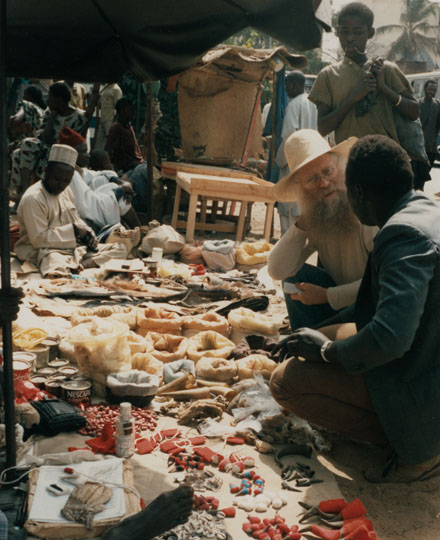
natural relations
[102]
In 1989 herman de vries published natural relations: eine skizze [= a sketch]. The title is not without a gentle irony, for this 'sketch' is a hardcover volume of 797 crowded pages, the exhaustive summation of many years research in the library, in the field and in the marketplaces of the world. Into this capacious portmanteau of a book de vries packed an extraordinary body of information and knowledge concerning the medicinal and psychedelic - 'mind-moving' - properties of plants and their pharmacological derivatives. natural relations draws upon extensive sources in anthropology, philology, botany, ethnobotany, mycology, phytochemistry, folklore, herbal history, pharmacology; on information supplied by shamans, herbalists, holy men and shopkeepers in the markets of India and North Africa; and on the artist's own experience, and that of others, of the effects on body and mind of herbs, plant derivatives and other substances.
[...]
There can be no proper understanding of de vries's complex/simple artistic philosophy that does not take account of the centrality to his vision of the cultural significance of the old wisdom of 'natural relations'. At its heart is a desire to reinstate and elaborate the forgotten knowledge and understanding of the vegetable kingdom, from subterranean fungus to great forests, as the home of our human terrestrial life, the provider of all we need to survive, the vital shelter and source of our well-being on earth. The revival of this ancient lore can only be enhanced by the findings of the modern natural sciences: 'within the coherent self-regulating system of nature, the existence of so many diverse vegetable substances is no accident for they have functions within the system, not only for the plants themselves, but even more for the
[103]
other organisms within this complex system, which [theodor] schwenk appropriately described as "the sensible chaos"'.
de vries's many-faceted understanding of these things, grounded as it is in his history as a professional scientist and also in his personal experience of mind-moving plant and mushroom derivatives and of psychedelic drugs, including LSD, is the mainspring of a deeper politics than that described as 'environmentalism'. For as well as its conscientious concern for material and recreational utility, it comprehends a loving consideration of all the other living things that share this life space, and a consciousness of the spiritual and metaphysical aspects of human
[104]
life - of those things 'of which we cannot speak'
[...].
[108]
After a discursive introduction, the work [= natural relations : eine skizze] is held together, in fact by the extensive 'catalogue', a directory of almost two thousand plants (the last entry is 2031, but some numbers are missing from certain of the sections) that are known to have medicinal or 'mind-moving' properties.
The catalogue is divided into sections relating to the geographical sources of specimens - Morocco, Eschenau, Delhi, Senegal - and of information about them. The plants and their derivatives are the real 'things' whose names and physical qualities are the very object of the monumental effort to remember and record. This extensive listing is itself a kind of litany, a roll call, and, as the epigraph of the book suggests, a memorial: 'zum gedächtnis dem, was vergessen ist - in memory of what is forgotten'. Among other things, natural relations is an elegy to the innumerable plants whose healing and sacred virtues have been lost to human use, and a lament for a lost wisdom.
The total project centred on natural relations culminated in the publication of the book by the Karl Ernst Osthaus-Museum in Hagen, to accompany an exhibition and the installation there of
[109]
the locked paradise. This consisted of a greenhouse, placed in the gallery, containing living specimens, collected by de vries, of twenty-one 'mind-moving' plants, including various species of thorn-apple (Datura), cannabis indica, poppy, morning glory, tobacco, peyotl, tea, coffee, and others. Of the most significant plants in the defining category, only that of the coca was absent its inclusion forbidden by the Federal authorities. The work was both a celebration of the beauty and value of the plants, and a warning that the loss of their properly integrated uses, sacred and medicinal, was a sign of man's increasing alienation from his own biosphere, and of the individual from his 'life-space'.
The crowded glass cabinet, a kind of garden into which the spectator could look, but whose door was officially sealed against entry, presented an image of a green Eden, like a miniature and special version of the botanical garden glasshouses that inspired Henri Rousseau's visions of paradise. Its vegetable inhabitants, moreover, could be acknowledged as companions of man in an ancient natural history of beneficial interrelations. Now this paradise may be lost. Those living connections are disrupted, and modern man is estranged from the green world around him. From being within that Edenic life space, he has become a spectator of it,
[110]
viewing it 'as through a glass darkly'. Man's acquisition and elevation of one kind of scientific knowledge has entailed the loss of another in which poetry and science are as one [...].
[source: Passage from Mel Gooding, herman de vries. chance and change (Thames and Hudson : London 2006) 102-110.

[photo susanne de vries]